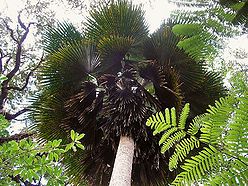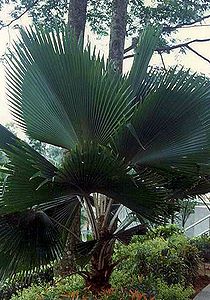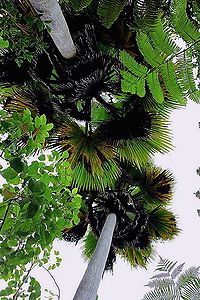Pritchardia beccariana
<google>CH02</google>
| Pritchardia (pritch-AHR-dee-uh) beccariana (bek-kar-ee-AHN-ah) | |||||||
|---|---|---|---|---|---|---|---|
 Hawaiian rainforest. Photo by Metrosideros, edric. | |||||||
| Scientific Classification | |||||||
| |||||||
| Synonyms | |||||||
|
| |||||||
| Native Continent | |||||||
|
| |||||||
| Morphology | |||||||
| |||||||
| Culture | |||||||
|
| |||||||
| Survivability index | |||||||
|
| |||||||
| Common names | |||||||
|
| |||||||
Contents
Habitat and Distribution
Occurs on the northeastern and eastern slopes of Mauna Loa, on the Big Island of Hawaii, in wet forests between 300-1300 meters elevation.
Description
Solitary fan leaved palm with large, flat, round leaves with shallowly divided leaf blades and stiff segment tips. This is one of the taller Pritchardias growing up to 20 meters tall. Inflorescences are shorter than or equal to the petiole length and the fruits are large, approximately 40 x 30-40 mm globose to ellipsoid.
To 20 m tall; proximal margins of petiole with slight to moderate fibers; leaf blade nearly flat, divided 1/5-1/4, abaxial surface incompletely covered with scattered lepidia, segment tips stiff; inflorescences composed of 2-4 panicles, shorter than or equaling petioles in flower and fruit (infrequently slightly exceeding petioles in fruit), panicles branched to 3 orders, rachillae glabrous to clothed with scurfy indumentum in flower, glabrous in fruit; fruits 40 x 30-40 mm, globose to ellipsoid. (Hodel, D. 2007) Editing by edric.
Pritchardia beccariana is distinct in its large, flat, round, shallowly divided leaf blades incompletely covered abaxially with lepidia and with stiff segment tips, inflorescences shorter than or about equaling the petioles, and large fruits. It is similar to P. gordonii and P. schattaueri, both of which differ in their leaf blades with pendulous segment tips and petiole margins with an abundance of conspicuous fibers proximally. (Hodel, D. 2007)
Culture
Requires constantly moist soil, and can take shade or full sun, although grows considerably faster in sun.
Comments and Curiosities
Etymology: Pritchardia name is dedicated to William Thomas Pritchard (1829-1907), British official stationed in Fiji in the 19th Century, British counsul in Fiji, adventurer, and author of Polynesian Reminiscences in 1866. The specific epithet beccariana is named for the Italian botanist Odoardo Becarri (1843-1920), perhaps best known for "discovering" the Titan arum, the plant with the largest unbranched inflorescence in the world, in Sumatra in 1878.
The names Hāwane and Wāhane can refer to either the fruits or the trees themselves.
This loulu is found from about 1000 to 4200 feet in wet forest on Mauna Loa, Hawaiʻi Island. It probably originally occured lower, perhaps to sea level, but urbanization, farming, and reforestation projects have destroyed the forest at lower elevations.
The hard wood of the trunk of taller species of loulu were fashioned into spears by early Hawaiians.
The fruits called hāwane or wāhane were peeled and eaten by early Hawaiians. They collected young fruits. The flavor of young fruit with the soft interior is similar to coconut. The trunks loulu were notched for climbing to gather the immature fruits and fronds. Older specimens still bear notches that can be seen today.
Loulu or Kilauea pritchardia. Endemic to the Hawaiian Islands (Hawaiʻi Island only) Oʻahu (Cultivated). The fruits called hāwane or wāhane were peeled and eaten by early Hawaiians. They collected young fruits. The flavor of young fruit with the soft interior is similar to coconut. The trunks loulu were notched for climbing to gather the immature fruits and fronds. Older specimens still bear notches that can be seen today. The fronds, or leaves, called lau hāwane were used by the early Hawaiians for thatching and more recently as plaiting such as papale (hats) and fans. (David Eickhoff), edric.
"One of the larger-leaved Pritchardias. Does fairly well in southern California in partial shade situations, but is a slow plant. Native to Hawaii. Leaves are semicircular to somewhat less of a circle than that. ONly split about 1/10 of the way down the leaf." (Geoff Stein). edric.
External Links
- Glossary of Palm Terms
- Pronunciation Key
- http://myloulu.wordpress.com/2010/09/13/the-island-of-oahu/
- http://myloulu.wordpress.com/2010/09/08/the-island-of-maui/
- http://myloulu.wordpress.com/2010/09/27/the-islands-of-niihau-and-nihoa/
- http://hanapalms.wordpress.com/2010/07/
- http://www.biomedcentral.com/1471-2148/12/23
References
Special thanks to Geoff Stein, (Palmbob) for his hundreds of photos, edric.
Special thanks to palmweb.org, Dr. John Dransfield, Dr. Bill Baker & team, for their volumes of information and photos, edric.
- IMAGE GALLERY
Many Special Thanks to Ed Vaile for his long hours of tireless editing and numerous contributions.






































